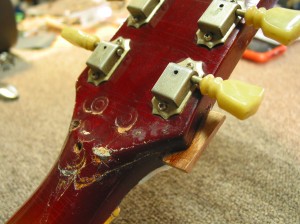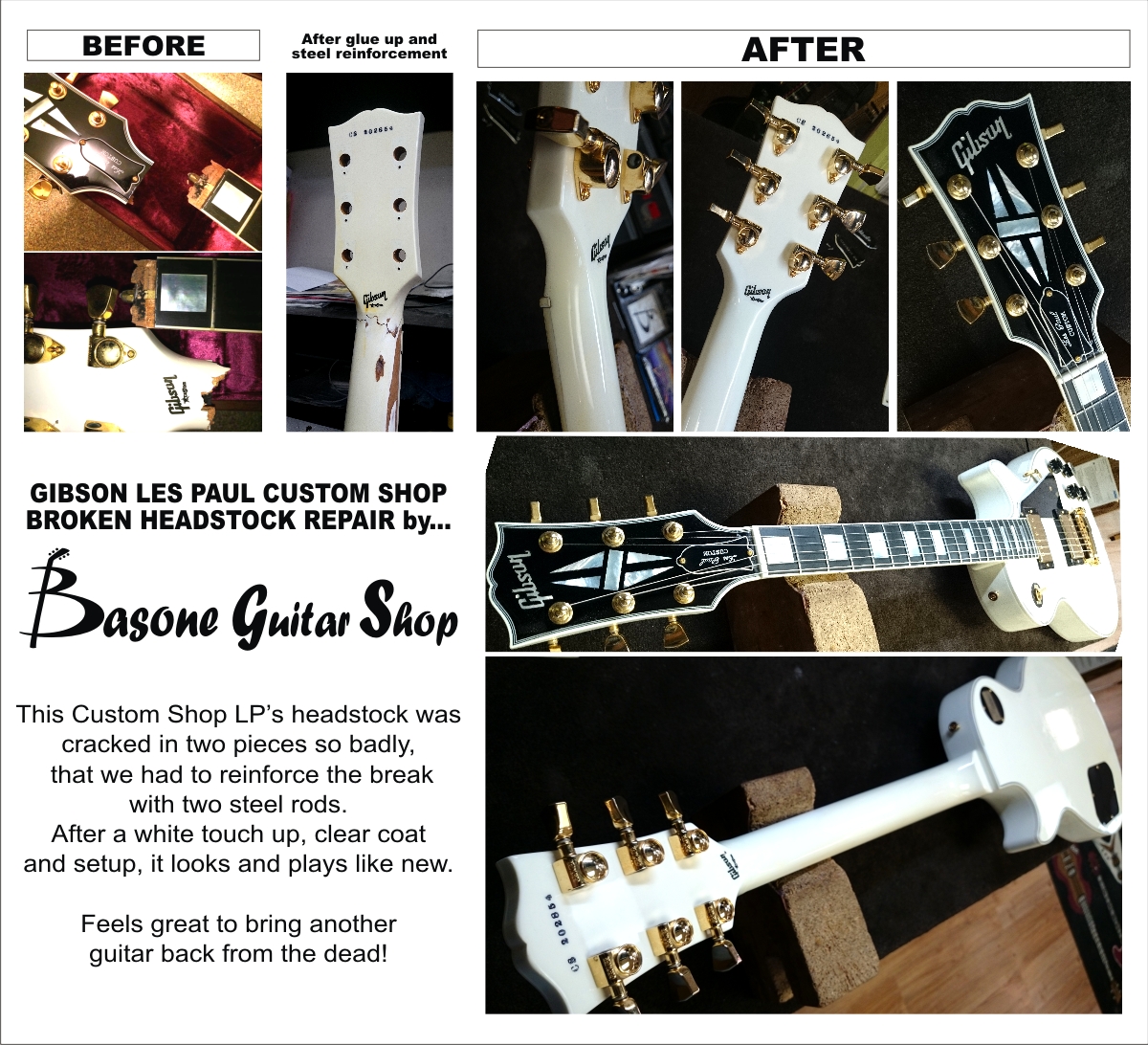Gibson Les Paul Cracked Neck Repair

I see this all the time, and I simply don't understand it.Why are there so many Les Pauls with cracked headstocks, or folks who have repaired them and want to sell them all messed up?I understand there is a weak point on the neck at the headstock, but I've had les paul's for years, and simply don't understand, since they really seems like very solid guitars.can folks be dropping them on their headstocks?are they banging into things, wacking the headstock into something hard that cracks it?what gives here? I see this all the time, and I simply don't understand it.Why are there so many Les Pauls with cracked headstocks, or folks who have repaired them and want to sell them all messed up?I understand there is a weak point on the neck at the headstock, but I've had les paul's for years, and simply don't understand, since they really seems like very solid guitars.can folks be dropping them on their headstocks?are they banging into things, wacking the headstock into something hard that cracks it?what gives here?We honestly repair about 5 Gibson headstocks every single month, it's so common. You mentioned the weak point, and that's due to the tilted back headstock design. That weak point takes all the shock anytime the guitar falls, forward or backward.
Also, 95% of the LP breaks you see have mahogany necks. Mahogany is much weaker than maple and much easier to crack or break. I just think that normal falls, bumps or abuse that most guitars take with no problem ends up breaking the headstock on LP's. Part 0f why we see s0 many headst0ck breaks is because 0f gibs0ns headst0ck pitch angle which puts al0t 0f string tensi0n and why gibs0n d0esnt need t0 use string trees like fender etc. The headst0ck angle pitch is als0 1 reas0n why they have such nice sustain. I w0uld see al0t 0f breaks especially 0n 70's l.p. Deluxes as I think the 3 piece neck might have s0mething t0 d0 with this als0, as c0mpared t0 the 1 piece mah0gany.
I pers0nally never w0uld buy a lp with a headst0ck break as it w0uld b0ther me and als0 the resale value gets killed. It is said by s0me that a pr0perly repaired headst0ck is actually str0nger then when new, I still w0uld rather n0t b0ther with it. Part 0f why we see s0 many headst0ck breaks is because 0f gibs0ns headst0ck pitch angle which puts al0t 0f string tensi0n and why gibs0n d0esnt need t0 use string trees like fender etc. The headst0ck angle pitch is als0 1 reas0n why they have such nice sustain.
I w0uld see al0t 0f breaks especially 0n 70's l.p. Deluxes as I think the 3 piece neck might have s0mething t0 d0 with this als0, as c0mpared t0 the 1 piece mah0gany. I pers0nally never w0uld buy a lp with a headst0ck break as it w0uld b0ther me and als0 the resale value gets killed. It is said by s0me that a pr0perly repaired headst0ck is actually str0nger then when new, I still w0uld rather n0t b0ther with it.Get a new keyboard dude!
Part 0f why we see s0 many headst0ck breaks is because 0f gibs0ns headst0ck pitch angle which puts al0t 0f string tensi0n and why gibs0n d0esnt need t0 use string trees like fender etc. The headst0ck angle pitch is als0 1 reas0n why they have such nice sustain.
I w0uld see al0t 0f breaks especially 0n 70's l.p. Deluxes as I think the 3 piece neck might have s0mething t0 d0 with this als0, as c0mpared t0 the 1 piece mah0gany. I pers0nally never w0uld buy a lp with a headst0ck break as it w0uld b0ther me and als0 the resale value gets killed. It is said by s0me that a pr0perly repaired headst0ck is actually str0nger then when new, I still w0uld rather n0t b0ther with it.Get a new keyboard dude!Seriously, JoePete.
You're contributing well thought out information here, and I can barely read it cuz it makes my eyes do this:Post a WTB in the classifieds, I bet someone's got a keyboard they'll give you for free! I have that I purchased about 11 years ago? I think right when they came out. Maybe 10 years ago.
Anyway, this bastard has been abused to all hell. Its tattered with chips and scratches and everything, and on top of that, I have used excessively heavy strings for 8 out of the 10 years on it (between 64 and 70g, B standard tuning). I've never had it crack on me luckily, and it has certainly been dropped. Not by me most of the time actually. As I stated in another thread, I have the equipment mostly for the guitarists that join my band, though it is nice for clients to use should they need. What I have noticed though, is the fretboard seems to be cracking along the seam, or maybe the glue is just separating.

Either way, besides some switch trouble, this thing has been really damn reliable.
Gibson Les Paul Neck Repair

Yikes.If you've been reading my stuff for a while, you've probably spotted a few different examples of neck breaks. Most of these have been up at the headstock end as that's the more likely place for a break.It can happen down the other end too, though.
This Les Paul took a tumble and broke in a nasty way. The exterior damage is obvious but it's pretty certain that crack extends into the neck tenon too (the tenon's the bit that gets glued into the neck pocket in the body).This neck needs to come out to be properly repaired.It's not too often that I need to remove a Les Paul neck, which is lucky as it's a relatively involved job. With a strong cup of tea to steel myself, I set to work.
Gibson Les Paul Replacement Parts
First up, a few frets need to come out. To remove this neck, I need to soak and steam the glue out and that means getting access to the internals of the neck joint. I do this by drilling small 'access' holes. These are drilled in the fret slots. When it's all done, I'll fill the holes with rosewood plugs and re-cut the slots. All of this is hidden by the refitted frets.Your eagle-eyes will have noticed a little dot on each (numbered) fret. These frets will be refitted and the dot tells me which is the bass end.Keeping fingers crossed, I take a look under the neck pickup, hoping for a long tenon.
Gibson Les Paul Neck Dimensions
If I could have seen the end of the tenon, I'd know exactly what size it was so I could position my holes to accurately access the sides of the neck joint (if it's not clear what I mean here, a photo later on might clarify things).Since all of this tenon is hidden, I have to measure out the usual Gibson size and position for this guitar and hope that it's built properly to spec.In the photo, above on the right, you can see the pencil marks I've used to plot out the tenon and the holes I've drilled to get access to the joint. This one's a bit weird-looking, I'll admit.In the left image, I'm using a syringe to insert boiling water into the holes I've drilled. I give it a few seconds and then suck it back up again. What comes out is cooler water with some manky-looking dissolved glue. I repeat this process a lot over the course of a couple of days. A Les Paul neck joint is a hell of a strong joint and doing this gives me a little bit of a head start before I hit it with the steam.Which is what's happening on the right.
That nozzle lets me get piping hot steam deep into the joint. The heat and moisture helps to dissolve more glue and, after some time and work, the glue eventually lets go.